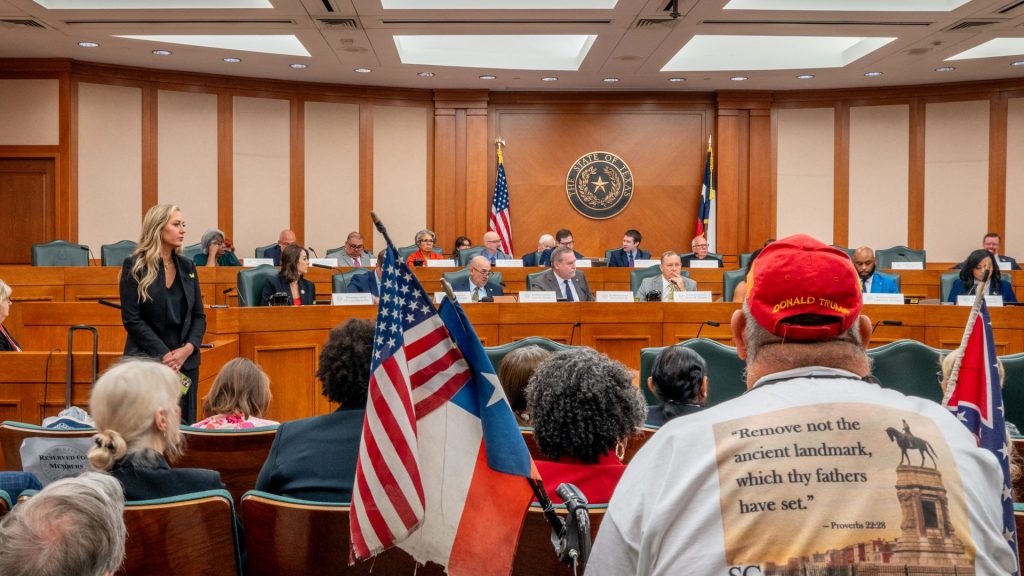Redistricting attempts heating up around the country ahead of 2026 election

A hearing at the Texas Capitol on Friday, Aug. 1, let voters weigh in on the Republican plan to redistrict before next year’s election. It comes as Democratic politicians in other states plan countermeasures.
Redistricting in Texas
Top Republicans, including President Donald Trump, have made it clear they want to change the maps to get the GOP more seats in the United States House of Representatives next year.
“What voters are seeing now is elected officials saying the quiet part out loud — that this is, in fact, an exercise designed entirely for the purpose of partisan warfare, a food fight between the two major parties,” Dan Vicuna, senior policy director for fair voting and representation at Common Cause, told Straight Arrow News.
In a hearing that lasted most of the day, voters in Texas got to have their say on their state’s redistricting plan.
“With racist surgical precision, these maps reflect gerrymandering with a scalpel, dipped in injustice which amounts to legislative sin,” Dr. Frederick D. Haynes III, a pastor at a local church, said at the hearing. “The bible, often quoted by many here, has a prophet by the name of Isaiah, who warns woe to those who legislate evil.”
Most of the public comment was against the move, but some Republican voters also came to voice their approval, including a delegate at last year’s Republican National Convention.
“As Texans, we should absolutely support redistricting,” Lisa Dyer said. “Not to gain advantage, but to make sure every Texan is fairly and equally represented.”
That topic of equal representation is part of the backlash against the redrawn maps.
“This started with President Trump ordering his Department of Justice to write up a bad faith legal interpretation of Texas’ map, right — a map that civil rights experts have examined and are currently litigating as discriminatory against people of color in the state, and Trump’s Justice Department decided to make the argument that was: In fact, those maps were too good for people of color,” Vicuna said.
Despite the backlash and calls of gerrymandering, there’s nothing illegal happening to prevent the move.
“The Supreme Court has said that extreme partisan gerrymandering is incompatible with democratic principles, but it’s also said that federal courts cannot do anything about it because there are no clear judicial standards for enforcing that principle,” Rick Pildes, a professor of constitutional law at New York University, told Straight Arrow News. “That means that unless state laws, the state constitution or the state supreme court prohibit partisan gerrymandering, state legislatures can get away with doing it.”
Democratic redistricting
The fact that state laws can make partisan gerrymandering difficult is exactly what will make it hard for Democratic states like New York and California to copy Texas and produce more Democratic House seats.
Lawmakers in both states have floated plans to do just that.
In California, maps are drawn by a nonpartisan commission with a high level of checks and balances.
“The commission did incredible work last cycle, resulting in zero lawsuits challenging the maps, which is incredibly rare in the redistricting space,” Vicuna said.
But California Gov. Gavin Newsom talked about calling for a special election later in 2025 to have voters approve new House maps that would create more seats for Democrats.
“That strikes me as patently cynical as an argument,” Grant Reeher, a political science professor at Syracuse University, told Straight Arrow News. “He’s doing this in a deeply blue state on the assumption that the voters will be motivated to come out and sort of do their part to match districting shenanigans in Texas with their own districting shenanigans.”
Democrats in New York have the same end goal, but with a different plan. Their plan more resembles the plan in Texas — to just redraw the maps mid-decade.
However, New York state laws all but prohibit that from actually happening. It would require an amendment to the state constitution, which takes some time to put together.
“There’s no way you’re going to be able to do that before the midterm elections,” Reeher said.
Even if either state would be able to redistrict, it might be hard to gain seats because the states are already so extensively gerrymandered.
Impact on America
If you’re a voter reading this and you’re thinking what you’re supposed to think about all of it? No matter who we asked, the answer was the same.
“We are going further and further down some rabbit hole, and it doesn’t lead to any place good, and it’s another step in what I would regard as a descent into just some new level of hyperpartisanship that is not going to be good for the country,” Reeher said.
Pildes echoed that sentiment.
“This race to the gerrymandering bottom between states is not good for voters or for American democracy more generally,” Pildes said. “It creates enormous cynicism and disdain for the democratic process. Of the countries that use legislative districts to elect representatives, we are the only one that puts that power exclusively in the hands of partisan, self-interested actors — that is, the state legislatures.”
Vicuna and Common Cause have fought redistricting all the way up to the U.S. Supreme Court as recently as 2019. He said whenever bad maps get drawn and implemented, there will be people to fight back.
“If the states continue with this food fight at the national level, Republican versus Democratic states, we’re going to be there,” Vicuna said. “We’re going to show up to make sure that the people have a voice. They’re going to testify and talk about their communities. And if maps are passed and they’re problematic, racially discriminatory violations of state partisan gerrymandering bans will go to court, so we’ll be ready for this fight.”
Vicuna’s organization, though seen as left-leaning by some, has challenged both Republican and Democratic attempts at redrawing legislative districts to benefit a respective party over the other.





